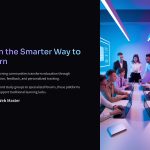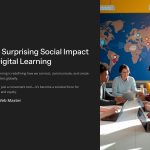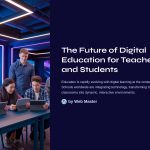
 Hybrid education is rapidly becoming the cornerstone of modern learning environments, blending the best of both traditional and digital methods. With its flexibility, it offers students the opportunity to benefit from in-person interactions while still taking advantage of the expansive resources and flexibility of online learning. As educational institutions continue to innovate, hybrid education is reshaping how we think about the classroom. But what exactly does this mean for students and teachers, and how can it shape the future of education? In this post, we will explore the core aspects of hybrid education, its benefits, challenges, and why it’s gaining momentum worldwide.
Hybrid education is rapidly becoming the cornerstone of modern learning environments, blending the best of both traditional and digital methods. With its flexibility, it offers students the opportunity to benefit from in-person interactions while still taking advantage of the expansive resources and flexibility of online learning. As educational institutions continue to innovate, hybrid education is reshaping how we think about the classroom. But what exactly does this mean for students and teachers, and how can it shape the future of education? In this post, we will explore the core aspects of hybrid education, its benefits, challenges, and why it’s gaining momentum worldwide.

What is Hybrid Education? A Comprehensive Overview
Hybrid education, also known as blended learning, is a teaching method that integrates traditional classroom experiences with online learning. This approach allows students to benefit from both in-person interaction with teachers and peers, while also utilizing the flexibility and resources of online materials. Hybrid models vary in their execution; some may have a set schedule where part of the instruction is delivered online, while others may allow students to choose between in-person and virtual attendance.
Key Features of Hybrid Education:
- Flexibility: Students can learn at their own pace and from different locations.
- Technology Integration: A combination of digital tools like videos, e-books, and learning management systems (LMS) to enhance the learning experience.
- Personalization: Teachers can cater to individual student needs by leveraging both in-person and virtual teaching methods.
As the digital landscape continues to evolve, the role of hybrid education is becoming more prominent, with many institutions adopting it for its ability to reach a broader range of students.

The Benefits of Hybrid Education: Why It’s the Future of Learning
Hybrid education offers several advantages over traditional educational methods, particularly in terms of accessibility, engagement, and personalized learning. Here are some of the most notable benefits:
1. Increased Accessibility
One of the primary benefits of hybrid education is that it breaks down geographical barriers. Students from remote locations or those with mobility issues can still participate in learning opportunities that they might not otherwise have access to. Whether they are in rural areas or balancing work and study, hybrid models allow them to engage with course content from anywhere with an internet connection.
2. Flexibility and Convenience
Hybrid education provides students with the flexibility to choose when and where they want to learn. This flexibility is particularly beneficial for adult learners and working professionals who may not be able to attend traditional in-person classes. For students in high school or college, it can also help them manage their schedule better by combining online lessons with in-person activities when necessary.
3. More Personalized Learning Experiences
With a combination of in-person and online instruction, hybrid education allows for a more personalized learning experience. Students can engage in self-paced online lessons, revisit materials they found challenging, and receive tailored feedback through digital platforms. Teachers can use data from learning management systems to monitor student progress and intervene when necessary.
Challenges and Considerations in Implementing Hybrid Education
While hybrid education has many advantages, it also comes with its own set of challenges. These obstacles must be considered to ensure that hybrid models are implemented effectively.
1. Technology Accessibility
Not all students have equal access to the necessary technology for online learning. For hybrid education to be successful, institutions must ensure that all students have access to reliable devices, stable internet connections, and the necessary digital tools. Schools in underserved or low-income areas may face additional challenges in providing these resources.
2. Teacher Training
Teachers must be adequately trained to handle both online and in-person aspects of hybrid teaching. This includes using digital tools effectively, managing online platforms, and ensuring that online students are equally engaged as those attending classes in person. Professional development programs will be critical to preparing educators for this shift.
3. Maintaining Student Engagement
One of the main challenges in hybrid education is ensuring that students remain engaged both in class and online. With the distraction of being at home, students might find it difficult to focus or feel disconnected from their peers and instructors. Effective communication strategies, interactive online lessons, and fostering a sense of community are crucial to keeping students motivated.

The Future of Hybrid Education: Trends and Innovations
As hybrid education continues to evolve, several trends and innovations are likely to shape the future of learning. Here are some key developments to watch:
1. Integration of AI and Adaptive Learning
Artificial intelligence (AI) is beginning to play a significant role in hybrid education. AI-powered platforms can personalize learning experiences by adapting lessons to each student’s needs, providing real-time feedback, and offering recommendations based on progress. This technology can make learning more efficient and tailored to individual learning styles.
2. Virtual Reality (VR) and Augmented Reality (AR)
VR and AR technologies are increasingly being incorporated into hybrid learning environments to enhance student engagement. These technologies allow students to explore immersive learning experiences, such as virtual field trips, simulations, and hands-on activities that are not possible in traditional classrooms.
3. Gamification
The use of gamification in hybrid education is another exciting trend. By incorporating game mechanics such as rewards, challenges, and leaderboards, educators can increase student motivation and participation. Gamification can make learning more fun and interactive, especially in online environments where engagement can sometimes lag.

Conclusion: Embracing the Hybrid Education Revolution
Hybrid education is not just a temporary solution but a fundamental shift in how we approach teaching and learning. With its ability to offer flexibility, accessibility, and personalization, hybrid education is poised to become the standard model for many educational institutions. However, to realize its full potential, schools and educators must overcome challenges related to technology, teacher training, and student engagement. By embracing these changes and leveraging emerging technologies, hybrid education can revolutionize the learning experience for students of all ages and backgrounds.
6imz_ Q&A: Common Questions About Hybrid Education
1. Is hybrid education better than traditional in-person learning?
Hybrid education has its own set of advantages, particularly in terms of flexibility and accessibility. However, it depends on the student’s learning style and needs. Some may thrive in a traditional classroom, while others may benefit from the independence offered by hybrid models.
2. Can hybrid education work for younger students?
While hybrid education is often seen in higher education settings, it can also be effective for younger students if structured properly. Schools must carefully balance online learning with in-person activities to ensure that younger students remain engaged and receive the necessary social interactions.
3. What tools are essential for hybrid education?
Essential tools for hybrid education include learning management systems (LMS), video conferencing software, digital textbooks, and interactive online learning platforms. Additionally, a reliable internet connection and access to devices are critical for both teachers and students.
6imz_ Final Thoughts: The Promise of Hybrid Education
Hybrid education is reshaping how we approach learning in the 21st century. By offering flexibility, accessibility, and personalization, it empowers both students and teachers to create a more dynamic and effective learning environment. As technology continues to advance and educators refine their strategies, the future of education is likely to be hybrid in nature—blending the best of the physical and digital worlds to create more inclusive, engaging, and effective educational experiences.
*Capturing unauthorized images is prohibited*






